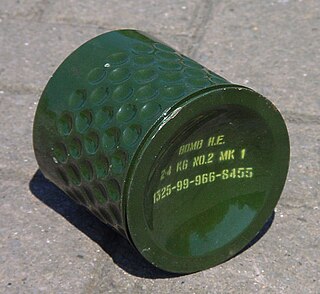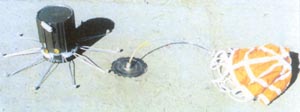
A naval mine is a self-contained explosive device placed in water to damage or destroy surface ships or submarines. Unlike depth charges, mines are deposited and left to wait until they are triggered by the approach of, or contact with, any vessel or a particular vessel type, akin to anti-infantry or anti-vehicle mines. Naval mines can be used offensively, to hamper enemy shipping movements or lock vessels into a harbour; or defensively, to protect friendly vessels and create "safe" zones. Mines allow the minelaying force commander to concentrate warships or defensive assets in mine-free areas giving the adversary three choices: undertake an expensive and time-consuming minesweeping effort, accept the casualties of challenging the minefield, or use the unmined waters where the greatest concentration of enemy firepower will be encountered.
The GATOR mine system is a United States military system of air-dropped anti-tank and anti-personnel mines developed in the 1980s to be compatible with existing cluster dispensers. It is used with two dispenser systems—the Navy 230 kg (500 lb) CBU-78/B and the Air Force 450 kg (1,000 lb) CBU-89/B. Additionally the mines are used with the land- and helicopter-based Volcano mine system.

In anti-tank warfare, an anti-tank mine is a type of land mine designed to damage or destroy vehicles including tanks and armored fighting vehicles.

RKG-3 is a series of Soviet anti-tank hand grenades. It superseded the RPG-43, RPG-40 and RPG-6 series of grenades. It entered service in 1950, and was still being used by insurgents in Iraq and Afghanistan into the 2000s and 2010s, against the vehicles of NATO forces.

The HB 876 mine was an air dropped area denial weapon. It was used as part of the JP233 runway denial system and the 'Hades' variant of the BL755 cluster bomb. As a result of the anti-personnel mine ban it was withdrawn from British Royal Air Force service, and the last stockpiles of the mine were destroyed on 19 October 1999.

The AT2 mine is a scatterable anti-tank mine developed by Dynamit Nobel. It can be scattered from artillery rockets or from mine laying systems, and is in service with the British, German and Norwegian armed forces. AT2 mines were donated to Ukraine by Germany.
The Adrushy is an Indian glass-reinforced, plastic-cased anti-tank landmine.
The VS-SATM1 is an Italian scatterable anti-tank landmine that was produced by Valsella Meccanotecnica SpA. The mine can be scattered by a GRILLO-128 man-portable single-tube launcher system or a VS-MDH helicopter based system. The mine has six pop-out fins which slow its descent and improve the dispersion characteristics.
The 4AHM-100, AHM-200, AHM-200-1, AHM-200-2, PMN-150, and PMN-250 are Bulgarian directional fragmentation mines that can be used with proximity fuzes to function as anti-helicopter mines.
The ATM 2000 and ATM 2000E are Austrian plastic cased anti-vehicle mines using Misznay Schardin effect warhead. The mine uses an electronic microprocessor controlled fuze with magnetic, seismic and pressure sensors allowing it to discriminate between targets. The mine can be laid by hand or by a mechanical mine laying system, and arms ten minutes after being laid. The mine is fitted with an anti-handling device, and can be command detonated.

An anti-handling device is an attachment to or an integral part of a landmine or other munition such as some fuze types found in general-purpose air-dropped bombs, cluster bombs and sea mines. It is designed to prevent tampering or disabling, or to target bomb disposal personnel. When the protected device is disturbed, it detonates, killing or injuring anyone within the blast area. There is a strong functional overlap of booby traps and anti-handling devices.

The FFV 028 is a series of steel cased Swedish anti-tank mines that use electronic fuzes. The mines are circular, with a large Misznay Schardin effect warhead in the center of the mine, with the fuzing and sensor electronics located in the dead space above the main charge. The design of the mine dates from the 1970s and uses a magnetic influence sensor to detonate the mine, making it able to attack the full width of armoured vehicles.
The HAK-1 is a Hungarian plastic encased anti-tank mine. It uses a Misznay Schardin effect warhead combined with an electronic acoustic and magnetic influence fuze. The mine can be programmed for an active life of between three hours and 150 days. Once the acoustic sensor detects a target, the magnetic influence sensor is used to detonate the mine at the optimal point. The warhead is capable of penetrating 45 mm of armour and producing a 130 mm diameter hole.
The VS-HCT series of mines are Italian plastic cased anti-tank mines that use Misznay Schardin effect warheads and have a dual seismic and magnetic fuze. The mines are no longer produced and differ in size and shape.

The HPD-1, HPD-2 and HPD-3 are a series of French electrically fuzed anti-tank landmines that use Misznay Schardin effect warheads. The entire series of mines conform to the United States MIL-STD-331.

The MN-111 is a Polish air-dropped anti-tank landmine. The mine is designed for use on soft ground. The mine is cylindrical with six spring-loaded fins attached to one end of the mine, with the cylinder drawn to a point at the opposite end which is topped with a small wind vane. The mine is stored with the fins wrapped round the outside of the mine. Once the mine is dropped from the aircraft the fins spring outward, acting as a drag parachute, slowing the rate of descent to a peak speed of about 60 meters per second. As the mine drops the wind vane spins, generating the power used to arm the mine.

Selectable Lightweight Attack Munition or is a small United States multi-purpose landmine produced by ATK Precision Fuze Company in Janesville, Wisconsin from 1992 to 2002. It has a passive infrared sensor, and a magnetic influence sensor which allow it to be used as a demolition munition, off-route mine, or full width belly attack mine.

The MN-121 is a Polish scatterable anti-tank mine, externally similar to the German AT-2 mine. The mine is cylindrical with ten wire legs which fold outward to keep the mine upright. The mine uses a magnetic influence fuze, which triggers the mine when a vehicle passes over it. The mine also has an anti-handling device which triggers the mine if it is moved. The mine's warhead is a shaped charge design containing approximately 700 grams of RDX. The manufacturer claims that it is capable of penetrating 60 millimeters of armour at an offset of half a meter.
In military munitions, a fuze is the part of the device that initiates function. In some applications, such as torpedoes, a fuze may be identified by function as the exploder. The relative complexity of even the earliest fuze designs can be seen in cutaway diagrams.

The MW-1 is a German munitions dispenser similar to the British JP233. It is designed to be carried on the Tornado IDS, although it can be carried on the Lockheed F-104 Starfighter and the McDonnell Douglas F-4 Phantom II. The MW-1 started to be phased out after the German Government ratified the Convention on Cluster Munitions in 2009.












